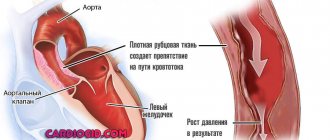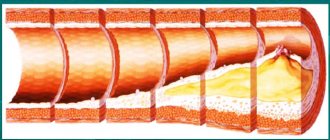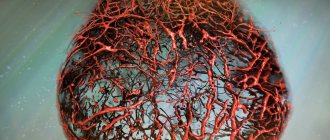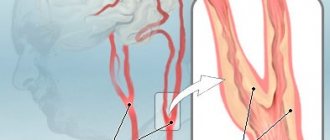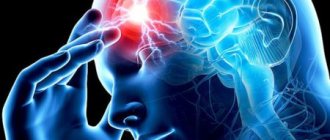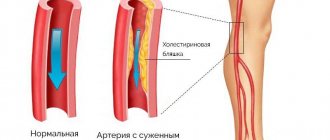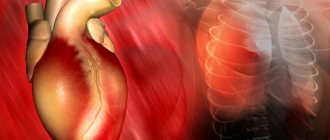Atherosclerosis is a thickening and hardening of the walls of the arteries, in which the lumen of the vessel “quietly and slowly” narrows, which impedes normal blood flow. This pathology is the cause of coronary heart disease, cerebral stroke, obliterating atherosclerosis of the lower extremities. This is a systemic process, it affects all arteries without exception.
The aorta is the largest vessel of the arterial bed, where the formation of atherosclerotic plaques is most often observed. It is important to know the signs of aortic atherosclerosis, the causes and stages of the process in order to prevent progression and begin to treat this pathology in a timely manner.
Localization of lesions
Atherosclerosis of the aorta can develop in any part of it. This is an arterial vessel of the systemic circulation, the largest in the body. It begins from the left ventricle, the expansion at the very beginning is called the root.
Main sections of the artery:
- Ascending - the area from the valve to the brachiocephalic trunk;
- Descending (thoracic) - the area from the mouth of the left subclavian artery to the diaphragm;
- An arc connecting the ascending and thoracic regions;
- Abdominal, which is located below the diaphragm.
The coronary (coronary) arteries branch from the ascending part, from which the heart muscle receives blood. Vessels supplying blood to the brain and upper part of the chest lead from the arch.
The descending section supplies blood to the lower part of the chest, and the abdominal section supplies the tissues and organs of the abdominal cavity.
Atherosclerosis of the aorta is one of the most common lesions. It is manifested by the deposition of cholesterol plaques on the walls of the coronary vessels.
Pathological formations are often localized in the arch area. In this case, atherosclerosis of the aorta can be of 2 types: non-stenotic and stenotic. In the first case, plaques are deposited on the walls of blood vessels. The stenotic process is characterized by the growth of plaques inside the artery.
If the valve is affected, plaques are deposited along its edges. Damage to the root of the artery leads to its hardening. The process also involves the mouths of other small vessels.
What is important to know
The main feature of the above disease is that not only atherosclerosis of the aortic arch can develop in the body, but also a similar pathology can appear in any part of the blood vessel. Since it is with the help of this arterial vessel that a large circle of blood circulation in the body is carried out, such a problem significantly affects the overall functioning of the entire human body.
Depending on which section the atherosclerotic changes in the aorta of the heart are located can be localized:
- in the ascending section of the arterial vessel (it begins with the valve and ends with the brachiocephalic trunk);
- in the descending or thoracic region (starts at the mouth of the left subclavian artery and ends with the diaphragm);
- in the arch of the aortic valve , responsible for connecting the ascending and thoracic sections;
- in the abdominal region : the answer to the question, atherosclerosis of the abdominal aorta, what is it, turns out to be a large number of cholesterol plaques blocking the normal blood supply to the body.
Common consequences of cholesterol plaques on the walls of blood vessels
In most clinical cases, the main cause of the above pathological condition is dyslipidemia. A similar problem may arise due to impaired lipid metabolism, which is determined by an imbalance of fatty substances in the human body.
Thus, the answer to the question, what is atherosclerosis of the aorta of the heart, is the proliferation of atherosclerotic plaques and the formation of fibrous tissue, which provokes impaired elasticity of the arteries and thickening of the walls, as a result - a narrowing of the vascular lumen.
The seriousness of the consequences that atherosclerotic heart disease can lead to is:
- slowing down blood circulation in the body;
- accumulation of platelets;
- development of thrombosis;
- the appearance of acid starvation.
In order to understand what atherosclerosis of the aortic arch is, it is worth taking into account the age-related predisposition of blood vessels to its development. Mostly this pathology appears in patients over forty-five years of age. In addition, problems with decreased elasticity and passage in the arteries more often occur in the male body.
How does atherosclerosis of the aorta develop?
Let's consider what atherosclerosis of the aorta of the heart is and why it develops. The main cause of the pathology is dyslipidemia. This is the name for a condition caused by a disorder of lipid metabolism. It indicates an imbalance of fatty substances in the body.
Lipids penetrate into the artery, and stains containing cholesterol appear on its walls. They grow into
on all sides, atherosclerotic plaques appear. Fibrous tissue forms in the affected areas. The artery loses its elasticity, its walls become denser, and the vascular lumen narrows.
Cholesterol plaques may disintegrate. All these processes cause a slowdown in blood circulation, lead to the accumulation of platelets, and the development of thrombosis. As a result, the artery narrows even more, and oxygen starvation develops.
Poor blood supply to the heart causes its dysfunction.
Risk factors
Atherosclerosis is a chronic disease in which atherosclerotic plaques appear on the walls of blood vessels. Such deposits consist of cholesterol, lipoprotein residues, blood cells, and connective tissue. A mature formation even sprouts its own vessels. An atherosclerotic plaque in small vessels can clog their lumen, and in large arteries such as the aorta, it can deform the artery itself and block the flow of blood into the outgoing vessels.
Aortic atherosclerosis develops very slowly – several decades. During this time, the walls of the artery are affected by many damaging factors. Therefore, it is impossible to name a clear cause of the disease. There is a list of risk factors that can lead to the development of atherosclerosis:
- age-related aging of arteries. In older people, the walls of blood vessels become more brittle and prone to injury. The critical age for men is after 50 years, for women – after menopause;
- high pressure;
- high cholesterol, LDL;
- smoking;
- excess weight;
- genetic predisposition;
- chronic stress;
- inactivity;
- chronic inflammatory diseases.
According to the International Classification of Diseases, 10th revision (ICD-10), aortic atherosclerosis is assigned code I70.
Causes of development of atherosclerosis of the aorta
Most often, aortic atherosclerosis is detected in people over 45 years of age. The incidence rate in men is significantly higher than in women. Atherosclerotic changes in the aorta can appear under the influence of factors that can be divided into 3 groups: removable, partially removable and irreversible.
Disposable:
- A diet containing large amounts of animal fats;
- Physical inactivity;
- Smoking, alcohol abuse.
Partially removable:
- Obesity;
- Dyslipidemia;
- Diabetes;
- Arterial hypertension;
- Infectious diseases;
- Chronic intoxication of the body.
Fatal:
- Genetic predisposition;
- Age from 40-50 years.
Causes
There are many factors associated with the development of aortic pathology. Atherosclerosis of the heart occurs both for individual reasons and for their combination. The risk group for aortic disease includes people who smoke, are prone to physical inactivity, are obese, have a hereditary predisposition, and patients with diabetes mellitus and infectious diseases. Other causes of aortic disease include:
- a diet that includes the consumption of animal fats;
- decreased physical activity;
- endocrine diseases;
- changes in hormonal levels;
- frequent stressful situations;
- high blood pressure;
- constant intoxication of the body;
- increased cholesterol;
- gender (men are more likely to get sick);
- bad habits;
- genetic predisposition.
Symptoms of atherosclerosis of the aorta
Symptoms of the disease can be different and depend on the location of the process. Atherosclerosis of the aorta in the area of the aortic valve is accompanied by symptoms characteristic of insufficiency or stenosis:
- Increased heart rate, especially when lying down;
- Pulsating sensations in the neck, head;
- Pain in the heart area (squeezing or squeezing);
- Noise in ears;
- Headache;
- Changes in heart rate;
- Dyspnea;
- Increased sweating;
- Dizziness;
- Weakness;
- Fatigue;
- Fainting.
Atherosclerosis of the aorta in the area of the root, arch, as well as lesions of the coronary arteries are quite common. All of them can provoke the development of complications with a fatal outcome.
Atherosclerosis of the aorta and coronary arteries is manifested by signs characteristic of angina pectoris, ischemic heart disease (coronary heart disease), and heart attack:
- Chest pain (burning or pressing);
- Shortness of breath, worsening when lying down;
- Vomit;
- Nausea;
- Dizziness;
- Blood pressure surges;
- Loss of consciousness.
Atherosclerosis of the aorta in the arch area is characterized by severe pain. The pain radiates to the left arm, shoulder, and shoulder blade. It intensifies with stress and physical activity. Unlike an attack of angina, pain cannot be eliminated by taking nitroglycerin.
The development of heart failure can be suspected in the presence of shortness of breath and suffocation. The arc increases in size, puts pressure on the recurrent nerve and on the trachea, which is manifested by dysphagia (difficulty swallowing).
How does the disease manifest itself?
Ischemic atherosclerosis is accompanied by angina pectoris, mild claudication and sharp spasms in the epigastric region. The thrombonecrotic type manifests itself in the form of a heart attack or stroke. Fibrous cannot be treated; this is the final stage of atherosclerotic vasoconstriction. Atherosclerosis of the heart vessels may have a number of additional symptoms.
Symptoms
According to statistics, people over 50 years of age are diagnosed with aortic atherosclerosis, the symptoms of which vary depending on the location of the cholesterol plaques. Typical symptoms of aortic valve pathologies include:
- increased heart rate, especially if the patient is in a supine position;
- throbbing pain in the back of the head and neck;
- sharp pain in the heart;
- tinnitus;
- increased sweating;
- dizziness;
- dyspnea;
- fainting;
- fatigue;
- lethargy, apathy.
Important information: Symptoms and treatments for carotid atherosclerosis
Manifestations of valvular atherosclerosis include symptoms of stenosis and heart failure. Pathologies of the arteries and aorta manifest themselves as:
- severe chest pain (burning or squeezing sensation);
- clouding of consciousness or loss of consciousness;
- increased blood pressure;
- dizziness;
- attacks of nausea;
- vomiting;
- shortness of breath.
Atherosclerosis of vessels located in the thoracic region has the following symptoms:
- arthralgia;
- dyspnea;
- pressure surges;
- increased heart rate;
- the appearance of hoarseness in the voice;
- migraine;
- dizziness;
- short-term amnesia;
- hyperemia;
- dysphalgia (difficulty swallowing).
The appearance of symptoms of atherosclerosis of the heart vessels requires immediate contact with a medical institution. In the early stages, atherosclerosis of the coronary vessels is often asymptomatic. Cholesterol plaques formed inside the blood vessels can provoke the development of complications.
Signs
The disease can be identified by a number of signs depending on the type of pathology and its location. The main signs of aortic atherosclerosis include severe pain. When the ascending aorta is blocked by fatty plaques, the joints hurt for several hours, and nervousness appears. Atherosclerosis of blood vessels located in the abdominal region manifests itself in the form of pain that does not have a clear localization. They may be accompanied by various disorders of the digestive tract:
- defecation disorders (constipation);
- excessive gas formation;
- loose stool.
The patient loses his appetite, which provokes weight loss. If the iliac arteries are clogged, then numbness of the lower extremities is possible. Poor circulation can lead to swollen toes and foot ulcers; muscle tone decreases.
Complications of aortic atherosclerosis
Atherosclerosis of the aorta of the heart often causes the appearance of an aneurysm (protrusion of the artery wall). Its consequences: Impaired myocardial function (heart failure). Manifested by shortness of breath, swelling, increased heart rate.
Dissection of the walls and rupture of the aneurysm, which causes death. Dangerous signs are: severe pallor, pulsation of the veins of the neck, loss of consciousness, hoarse, shallow breathing.
Atherosclerosis of the aorta, localized in the area of the valve and coronary arteries, often ends in death. When the arc is damaged, acute insufficiency of blood supply to the brain (stroke) develops, which is accompanied by loss of speech, paralysis, and paresis. A complication of atherosclerosis of the thoracic aorta is a dissecting aneurysm with probable rupture.
Atherosclerosis of the aorta, localized in the abdominal region, leads to the development of thrombosis of the visceral arteries. The patient's general condition deteriorates sharply and his stomach hurts severely. Painful spasms do not go away even after taking antispasmodics or strong painkillers. Such symptoms require immediate medical attention, since there is a risk of developing necrosis of intestinal loops and peritoneal peritonitis.
Other, no less dangerous complications of aortic atherosclerosis include renal failure and hypertension. In the first case, poor blood supply causes gradual cell death. In this case, the tissues are replaced by connective tissue. The development of hypertension is caused by impaired blood supply to the kidneys and activation of the renin-angiotensin-aldosterone system (RAAS).
Other complications of aortic atherosclerosis:
- Angina pectoris, which develops due to insufficient blood supply to the myocardium;
- Ischemia of organs and tissues, the cause of which is chronic oxygen starvation;
- Collapse (acute vascular insufficiency).
Consequences and complications
Failure to promptly consult a specialist for atherosclerosis of the heart vessels increases the risk of complications. These include:
- Dissecting aortic aneurysm. The pathology is rare; most cases end in the death of the patient. With an aneurysm, the aorta can rupture and blood enters the chest and abdominal cavity.
- Acute cerebrovascular accident. The patient develops a hemorrhagic or ischemic stroke, accompanied by loss of speech, paralysis and paresis. A complication develops with atherosclerosis of the branches of the aorta.
- Thrombosis of the mesenteric artery. In this case, necrosis of the intestinal walls occurs due to disturbances in blood flow in the abdominal cavity. This provokes the development of peritonitis, which requires urgent surgical intervention. Complications appear when large vessels of the abdominal cavity are blocked.
The stenosing type of atherosclerosis is complicated by acute circulatory disorders in the legs. Characteristic symptoms of the pathology are numbness of the toes, pain and tingling in the feet. The consequences of improper or untimely treatment also include arterial hypertension, thrombosis of intestinal vessels and renal failure.
Diagnostics
Diagnosis of aortic atherosclerosis includes: examination of the patient, history taking, instrumental, laboratory
research. At the appointment, the doctor listens to the patient’s complaints, measures blood pressure, assesses body weight, determines possible risk factors, and identifies signs of atherosclerosis of the aorta of the heart.
Laboratory diagnostics are carried out. The patient must undergo a blood test to assess the concentration of high and low density lipoproteins. The level of triglycerides and cholesterol is determined.
To assess the condition of the heart muscle in case of aortic atherosclerosis, an ECG is performed. To study the condition of blood vessels, angiography and aortography are used, which makes it possible to identify the extent of lesions, the presence of calcification, and aneurysms. Coronary arteries are examined using coronary angiography.
Ultrasound diagnostics makes it possible to identify:
- Deterioration of the main blood flow;
- Reduced vascular lumen;
- Presence of formations (plaques, blood clots);
- The appearance of aneurysms.
Blood flow velocity in aortic atherosclerosis is also determined by rheovasography.
To identify aneurysms, not only ultrasound is used, but also other techniques (MRI, CT). To detect artery protrusions in the thoracic region, computed tomography and x-rays are used. Aortography provides the most complete picture of the location, extent, and diameter of the aneurysm.
Development mechanism
The aorta is the largest vessel of the human body. As it moves through the body, it breaks up into several structures. Individual branches supply large organs and entire systems with blood.
This artery emerges from the heart and carries liquid connective tissue in a large circle. The pathological process is determined by several phases of development.
The reason for this is a metabolic disorder at a generalized level: there may be deviations in the metabolism of minerals or lipid structures, often together.
As a result of this phenomenon, stenosis (narrowing) or blockage of the blood vessel occurs. Depending on the volume of the pathological focus, one or another symptomatology appears.
If the aortic lumen is closed by no more than 25%, the intensity of the manifestations is minimal. Then everything is much more dangerous. The result is ischemia of organs and tissues, a general disturbance of hemodynamics, and failure of entire systems. Possible death.
Treatment of aortic atherosclerosis
Timely treatment of atherosclerosis of the aorta of the heart can improve the quality of life and prevent the development of complications. First of all, you need to adjust your lifestyle.
It is important to follow the rules of a healthy diet, for this purpose you need to exclude from the diet:
- Food containing large amounts of animal fats;
- Foods rich in trans fats (hydrogenated oils found in margarine, confectionery, baked goods);
- Food with a lot of salt;
- Eggs;
- Refined sugar;
- Strong tea, coffee.
For aortic atherosclerosis, preference should be given to the following products:
- Vegetables;
- Fruits;
- Legumes;
- Low-fat or low-fat dairy products;
- Products containing whole grains.
A balanced diet and exercise will help bring your weight back to normal. This is very important to reduce the risk of complications of aortic atherosclerosis.
Regular physical activity will help lower your bad cholesterol levels. It is also necessary to stop smoking and drinking alcohol.
Diet for atherosclerosis of the aorta of the heart
Ingestion of excess fat into the body along with food negatively affects blood vessels and leads to the formation of cholesterol plaques. Fat deposits disrupt lipid metabolism, leading to thickening of the walls. An integral part of therapy for atherosclerosis is a balanced diet - a menu adjusted to the consumption of healthy foods and a reduction in carbohydrate and fatty foods. Following a diet leads to the dissolution of plaques and helps cleanse blood vessels. Basic principles of a therapeutic diet:
- easily digestible food;
- reducing salt;
- low-calorie foods;
- fractional meals;
- small portions;
- dairy products;
- cottage cheese;
- fruits;
- high fiber vegetables;
- refusal of sugar, white bread, baked goods.
Drug treatment
Modern medications perfectly eliminate the symptoms of aortic atherosclerosis. The patient may be prescribed the following groups of drugs:
- Statins (Mevacor, Zocor, Pravachol, etc.), which lower the concentration of cholesterol in the blood by reducing its synthesis in the body. Side effects of medications include liver dysfunction.
- Nicotinic acid and its derivatives (“Acipimox”, “Enduracin”). They increase the concentration of high-density lipoproteins in the blood, reduce the level of triglycerides and cholesterol. The most common side effects are: vasodilation, rash, redness of the skin, gastrointestinal disorders.
- Bile acid sequestrants (Colestipol, Colesevelam). The mechanism of action is to combine cholesterol with bile acids and remove these substances from the body. The drugs have very few side effects, these include: constipation, nausea, flatulence, heartburn.
- Fibrates (“Bezafibrate”, “Gemfibrozil”, “Bezalip”). Suppress the synthesis of triglycerides in the liver, accelerate their removal from the blood. Side effects: vomiting, nausea, diarrhea, flatulence, negative effect on the nervous system.
- Beta blockers (Metoprolol, Propranolol, Anaprilin). They help eliminate pain and discomfort in the chest, and reduce blood pressure. Side effects include the following: reduction in heart rate, toxic effects, decreased blood sugar, exacerbation of asthma.
Treatment
It is not possible to completely cure atherosclerosis of the abdominal or other parts of the aorta.
Treatment is usually aimed at eliminating the provoking factor and stopping the development of the pathological process. After a comprehensive diagnosis and identification of seals in the lumen of the vessel, the doctor prescribes medications to the patient and also gives recommendations for lifestyle changes.
Intensive therapy usually lasts 3-4 months, but maintenance treatment is carried out for the rest of your life.
Proper lifestyle and diet
It is believed that the right diet can stop the formation of atherosclerotic plaques even without the help of medications. In this case, animal fats, smoked meats, foods rich in cholesterol, and alcohol should be excluded. The diet should be filled with lean meat, fresh vegetables and fruits, natural juices, and cereals.
The patient also needs to monitor his work and rest schedule. Adequate sleep should be at least 8 hours, especially at night. Everyday activity should include moderate exercise; physical inactivity is prohibited. Walking in the fresh air, water procedures, swimming pool, and swimming are useful.
Drug therapy
Medicines are prescribed to normalize the concentration of various lipid fractions, as well as to resolve existing cholesterol plaques.
The following groups of drugs are used for this:
- statins;
- fibrates;
- nicotinic acid derivatives;
- unsaturated fatty acids;
- antihypertensive drugs;
- drugs that improve the nutrition of arterial walls.
The medications described above belong to the prescription group and cannot be prescribed independently. Their dosage is selected taking into account the neglect of the pathology only by the doctor.
Surgical intervention
If the lesion cannot be compensated with the help of drugs, and they provoke a pronounced ischemic zone, the doctor decides on the need for surgical intervention. It can be performed using an endovascular method or open surgery.
The following surgical treatment methods are used:
- stenting - installation of a special dilating device - a stent - into the lumen of the vessel;
- bypass - creating bypass routes using the patient’s own veins;
- prosthetics - removal of the affected area and replacing it with a prosthesis.
Surgical treatment of aortic atherosclerosis
Surgical treatment of aortic atherosclerosis is prescribed in cases where the risk of a threat to life is high. The following types of operations are performed:
- Angioplasty. It consists of reconstructing the vessel, allowing to restore its lumen.
- Shunting. It involves the application of a shunt, which normalizes the impaired blood flow.
- If an aneurysm is detected due to aortic atherosclerosis, an operation is performed to excise it and replace the removed area with a synthetic prosthesis. If an enlargement of the aortic valve ring is detected, the valve is excised and replaced with an artificial one.
- Rupture of aneurysms in aortic atherosclerosis is treated only surgically. The operation is performed according to vital indications (emergency).
Complications
If the pathology is not treated, the consequences may be as follows:
- Hypertensive crisis.
- Myocardial infarction.
- Stroke (hemorrhagic/ischemic).
- Heart failure.
- Dissecting aortic aneurysm.
The prognosis directly depends on the damage to the aorta. The fact that people are ready to fight the disease also plays a role. If a person notices its symptoms in time and undergoes comprehensive treatment, the prognosis is favorable. People live with the disease, but they need to be diagnosed regularly.
In forensic medicine there is the concept of sudden death, which in 89% is caused by atherosclerosis of the aorta of the heart.
Traditional methods of treating aortic atherosclerosis
For atherosclerosis of the aorta of the heart, traditional medicine recipes are used only as an auxiliary treatment method. Garlic is a good remedy. Take 300 g of peeled, chopped garlic, place it in a 0.5 liter glass jar and fill with vodka. The product can be used after 3 weeks. Drink 20 drops daily, dissolved in 100 ml of milk.
You can mix garlic juice with honey in a 1:2 ratio. You need to consume it 4 times a day, preferably before meals.
This recipe is also used. Add the juice of 1 lemon and orange to 1 glass of boiled water, stir and drink. Take the product once a day (in the morning on an empty stomach).
As a tonic, it is good to use fresh cucumbers, raw beets, or drink freshly squeezed juice from them (daily, 0.5 tbsp.). These vegetables contain a lot of potassium, which has a positive effect on the heart and blood vessels.
Freshly picked plantain leaves are also used to treat aortic atherosclerosis. Wash them, chop them, squeeze out the juice. Mix it with honey in equal proportions. Cook over low heat for 15-20 minutes. Drink 1 table daily. spoon. The product must be stored in the refrigerator.
Symptoms of aortic atherosclerosis can be alleviated with rosehip tincture. Fill 2/3 of a glass jar (0.5 liter volume) with fruits and add vodka. Leave for 2 weeks, stirring daily. Then strain. Take 20 drops daily. (on a piece of sugar).
The following regimen is also effective: start taking it with 5 drops, increasing the dose by 5 drops every day. The maximum amount should be 100 drops. Then gradually reduce the dose by 5 drops per day to the initial five.
Modern types of treatment
Treatment of atherosclerosis involves three main methods:
- changing your lifestyle, reviewing your diet;
- taking medications;
- surgical intervention.
Usually the first is mandatory, and the other two are optional.
There are also many traditional methods of therapy, but most of them are not recognized by official medicine.
Lifestyle changes, diet
Atherosclerosis of the aorta in the initial stages can be slowed down without drugs. No treatment method can completely get rid of atherosclerotic plaques. Improvement in well-being in many patients is observed with:
- quitting smoking. Active or passive smoking has a damaging effect on the walls of the vessel. Quitting cigarettes and avoiding gatherings of smokers helps to significantly reduce the risk of developing complications of atherosclerosis;
- daily physical activity. Biking or walking, gardening, swimming, yoga or any other sport should become a mandatory daily part of your life. Just 30 minutes of exercise every day can significantly reduce cholesterol levels;
- normalization of weight. Getting rid of extra pounds takes extra stress off the heart and also normalizes cholesterol levels. Taken together, it has a beneficial effect on the patient’s health;
- minimizing stress. Try to avoid stressful situations and find time to relax. If you can’t cope on your own, seek professional help from a psychologist.
Diet for aortic atherosclerosis implies:
- avoidance of foods containing trans fats. They increase the content of bad lipoproteins and reduce the content of good ones. Trans fats are companions of fried foods and can be hidden in many prepared foods. It is necessary to carefully study the label for the content of undesirable components;
- The basis of the diet is food rich in fiber. Vegetables, fruits, cereals, legumes contain large amounts of soluble and insoluble dietary fiber. Both types of fiber improve the condition of the heart and blood vessels, and soluble ones also reduce LDL levels;
- minimum saturated fat. Red meat, especially fatty types, fatty cottage cheese, cheese, cream, egg yolk are those products whose content must be limited. They all increase bad cholesterol levels;
- Omega-3 fatty acids are an essential component of the diet. American doctors recommend eating fatty fish at least twice a week. Herring, mackerel, salmon, mackerel, tuna - contain an incredible amount of unsaturated fatty acids and are also a valuable source of protein. Vegetarians can get omega-3 fatty acids from flax seeds, almonds, and walnuts;
- adequate water intake. 1.5-2 liters of water/day helps normalize cholesterol levels. If the body does not receive enough water, it increases the concentration of sterol, protecting its cells from dehydration.
Medications
Late-stage atherosclerosis of the aorta requires the use of medications. Depending on the symptoms and general health of the patient, the doctor may prescribe:
- lipid-lowering drugs - a group of drugs that normalize the level of cholesterol, LDL, HDL, and cholesterol. Most often, modern therapeutic regimens use statins, which block cholesterol synthesis. The main representatives of the group are atorvastatin, rosuvastatin, simvastatin. With a slight increase in sterol levels, the patient may be prescribed fibrates, preparations of unsaturated fatty acids, bile acid sequestrants, nicotinic acid;
- Medicines that normalize blood pressure also ease the work of the heart. Bisoprolol, amplodipine, nitroglycerin, enalapril are often used to treat aortic atherosclerosis;
- corticosteroids – have an anti-inflammatory effect. If the course of atherosclerosis is aggravated by inflammation, the patient is prescribed prednisolone or related drugs;
- anticoagulants - reduce the risk of blood clots by reducing blood viscosity and preventing cell clumping. The most popular drugs are aspirin, ticlopidine, warfarin, streptokinase.
Surgical methods
Surgical treatment of aortic atherosclerosis is indicated for people with serious complaints about general health and a high risk of complications: stroke, myocardial infarction, rupture or dissection of the aorta. There are several surgical techniques:
- Excision of an atherosclerotic plaque is an operation during which the surgeon removes the deposit through an incision. The vessel and wound are sutured. The complexity of the manipulation is explained by the location of the aorta (along the spine), as well as its significance for the body, and the potential volume of blood loss.
- Angioplasty is a major operation during which the damaged area of the vessel is excised and replaced with a prosthesis.
- Balloon dilatation is a low-traumatic procedure that involves inserting a catheter with a deflated balloon. When the surgeon reaches the site of narrowing, he inflates and deflates the balloon several times. The existing narrowing is straightened out. An operation to treat aortic atherosclerosis may result in the installation of a stent - a frame that will hold the lumen of the vessel from the inside. This manipulation is called stenting.
Folk remedies
While there is no need to take medications, you can control the disease using traditional methods:
- Birch buds. Pour 5 g of the plant with a glass of water, bring to a boil, simmer for 15 minutes, remove from heat, let steep for 1 hour. Take half a glass of strained broth an hour before meals 4 times a day;
- Hawthorn flowers. Pour 5 g of flowers into a glass of boiling water and place in a water bath under the lid. After 15 minutes, remove and cool to room temperature. Bring the resulting volume to 200 ml. 30 minutes before meals, drink half a glass in the morning and evening;
- Elecampane roots. Pour 30 g of powder into 500 ml of vodka, leave for 40 days in a dark place. Drink 25 drops before meals;
- Walnut. Eat 100 g of nuts every day, dividing the portion into 3 doses;
- Rose hip. Grind the rose hips and pour them into a half-liter jar. The fruits should occupy two-thirds of the volume. Fill with vodka to the top. Leave in a dark place, shaking daily. Take 2 times a day, 20 drops.
Other causes of narrowing of the aortic mouth
Atherosclerosis of the aorta and aortic valve leaflets is the main cause of the accumulation of calcium deposits in older people, which leads to sclerotization of these structures. About 1 in 20 people over the age of 65 have some degree of aortic stenosis. But there are other causes of this pathology that occur at an earlier age. For example:
- Rheumatism of the heart . A disease that 50 years ago was quite common and was the main cause of narrowing of the aortic mouth. Fortunately, with the advent of antibiotics, cases of pathology development have become much less common.
- Bicuspid aortic valve. This congenital pathology is the most common cause of stenosis in young people. Instead of three petals, the human aortic valve consists of two. This makes him more vulnerable to calcium deposits and, accordingly, to the formation of stenosis, the symptoms of which may appear by the age of 40 - 50 years.
Bicuspid aortic valve
- Endocarditis is inflammation, both infectious and autoimmune, of the inner lining of the heart.
- Congenital aortic stenosis is a heart defect (formation of abnormal connective tissue located above or below the valve).
Regardless of the etiology, at a certain stage, severe calcification of the aortic valve occurs, which leads to the appearance of symptoms of narrowing of the aortic ostium. Atherosclerosis of the aorta, aortic and mitral valves is formed mainly in the elderly and senile age, and can also affect other valves of arteries and blood vessels.
We recommend reading about the signs of aortic atherosclerosis. You will learn about the reasons for the development of this pathology, pathogenesis, the age at which atherosclerosis begins, its insidiousness, and diagnosis. And here is more information about traditional methods of treating aortic atherosclerosis.
Typical manifestations
The symptoms of aortic sclerosis are determined by the location of the lesion.
The aorta has three main sections:
- ascending part;
- arc;
- descending part.
The origin of the aorta from the left ventricle is called the ostium. Cholesterol plaques can form in any of these sections or in several at once. Clinical manifestations do not appear immediately. This is due to the fairly wide lumen of the vessel and the slow growth of plaques.
Patients with atherosclerosis have a characteristic appearance (photo). They show signs of premature aging - early graying and baldness, wrinkled skin, clouded eyes, brittle hair and nails.
A person with atherosclerosis looks older than his age
An objective examination can reveal the following symptoms:
- Auscultation - the appearance of noise over the aorta;
- when measuring pressure on both hands - its unevenness;
- change in heart rate;
- pale skin, especially on the legs;
- impaired hair growth, dry skin on the legs.
To determine circulatory disorders, an Allen test is performed. The patient makes a fist and holds it up for 30 seconds. The doctor then pinches the patient's hand at the wrist and tells him to unclench his fist.
When blood flow is disrupted, palms and nails become pale. Then the hand is lowered and the time of appearance of normal skin color is recorded. Normally this time is 5-7 seconds.
Damage to the thoracic aorta
The ascending part and the arch of the aorta are combined under the name “thoracic aorta”.
Sclerosis of this department causes the following changes:
- valve dysfunction;
- pulmonary hypertension;
- ischemia of the heart muscle.
What is aortic root sclerosis? This is the formation of plaques at the very mouth of the vessel, where it leaves the left ventricle. This localization leads to overstrain of the left ventricular myocardium, disruption of all hemodynamics in the systemic circulation. Sclerosis of the aortic arch causes disruption of the blood supply to the brain.
The main manifestations of sclerodegenerative changes in the aorta and valves:
- attacks of heart pain such as angina pectoris;
- hoarseness of voice;
- swallowing disorder;
- persistent increase in blood pressure;
- frequent fainting;
- dizziness;
- noise in ears;
- change in character and intelligence;
- cardiac arrhythmias.
The pathological process in the vascular wall leads to its thinning and loss of elasticity. If the aorta is sclerotic, what are the dangers? This condition is dangerous due to rupture of the vascular wall with the occurrence of massive bleeding.
Abdominal aortic lesion
Most of the descending aorta is abdominal. When this department is damaged, all organs of the abdominal cavity, pelvis, and lower extremities are affected.
Symptoms of sclerosis of the abdominal aorta are:
- pain in the epigastric region that occurs after eating;
- bowel dysfunction - constipation or diarrhea;
- increased gas formation;
- loss of appetite and weight loss;
- decreased sensitivity in the legs, changes in gait;
- formation of trophic ulcers;
- women's menstrual cycle is disrupted;
- In men, prostatitis develops and libido decreases.
A complication of sclerosis of the abdominal aorta is thrombosis of the mesenteric (mesenteric) vessels. In this case, necrosis of the mesentery and then the intestines develops.
Damage area
The formation of growths and proliferation in blood vessels leads to atherosclerosis of the aorta. The blood entering the head for brain activity is depleted of oxygen. As a result, intellectual abilities and memory decrease.
A distinctive feature of atherosclerosis of the thoracic aorta from angina pectoris is the sensation of pain in the left, right arm, cervical region, under the shoulder blades on both sides. Nitroglycerin and its analogues do not reduce pain.
The occurrence of hypertrophic heart failure is accompanied by an attack of shortness of breath and lack of air. The heart muscle thickens in size. The upper pressure value increases, the lower one returns to normal.
The brain is susceptible to ischemic disease: short-term loss of consciousness, hypertension, headaches, loss of strength, and the appearance of convulsive attacks.
The abdominal region is susceptible to plaque in the vascular system. Bloating and constipation, impaired digestion, weight loss with constant food intake. Sexual dysfunction occurs.
When a blood clot forms in the femoral aorta and subsequent blockage occurs, gangrene appears. At an early stage, it is possible to remove infected tissue surgically. In severe situations, leg amputation.
An aneurysm appears in the chest. In severe forms, the aneurysm enlarges, followed by dissection, bleeding, and death.
Kidney failure develops due to cessation of blood circulation and tissue necrosis. The formation of connective fibers that begin to replace living cells.
Surgical intervention is used at the time of blockage of the coronary artery or aorta using endarterectomy.
During treatment with medications, it is allowed to use the traditional method. The product complements and enhances the positive effect. Any folk decoctions have side effects. It is recommended to consult with your doctor.
What information is missing from the article?
- Detailed review of medications
- More practical treatments
- Innovative developments in this area
- Qualified expert opinion
Preventive actions
To prevent the development of aortic atherosclerosis, it is necessary to monitor your health, increase the body’s protective functions, and lead a healthy lifestyle. If a person has a tendency to this disease, it is necessary to regularly undergo preventive medical examinations and donate blood for analysis, which determines the level of cholesterol in the blood. Giving up bad habits, eating right, playing light sports, eliminating stress factors are also important steps to reduce the risk of developing this dangerous vascular disease.
Consequences of pathology
The narrowing of the lumen between the left ventricle and the aorta, as well as the incomplete opening of the valve leaflets, create an obstacle, making it increasingly difficult for the heart to eject blood into the systemic circulation. Excessive work of the heart muscle leads to its thickening (hypertrophy), which in turn is realized in the appearance of so-called diastolic heart failure. The following symptoms occur:
- dizziness and fainting (especially common during physical activity);
- dyspnea;
- rapid heartbeat (as a rule, this is associated with the appearance of atrial fibrillation).
Atherosclerosis of the aorta with damage to the valve and coronary arteries is a fairly common phenomenon. The combination of the increased need for arterial blood of the heart muscle during stenosis and its lack due to atherosclerotic narrowing of the coronary vessels is the cause of chest pain. As a rule, it occurs during emotional or physical stress.
With a pronounced form of narrowing of the aortic mouth, the contractility of the left ventricle weakens, its dilatation (expansion) occurs, which ends in the development of irreversible heart failure. Sudden death is a fairly common occurrence in severe aortic stenosis.
Diagnosis of pathology
Diagnosis of aortic stenosis is not difficult. The appearance of symptoms such as shortness of breath, chest pain, dizziness that occurs during physical activity
loads allow one to suspect pathology. Sometimes, during an examination for another disease, the doctor may hear heart sounds characteristic of stenosis.
Another option for “preclinical detection” of the disease is the determination of aortic valve calcification during an X-ray examination of the chest.
The diagnosis is confirmed or excluded using echocardiography. Cardiac catheterization is sometimes ordered to determine the severity of the stenosis. This method is invasive. During manipulation, a special catheter is brought through the artery (femoral or radial) to the site of treatment, at the tip of which a sensor is located. As a result of the manipulation, the pressure on both sides of the valve is determined, which helps to assess the severity of the narrowing.


